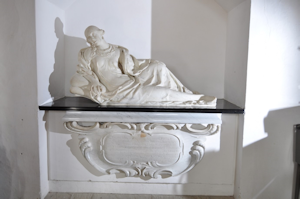
The disposition of the pock-marking shows what, at the time, may have been considered part of the 'portrait' element of the effigy. In other words, the marked face was central to the continuing biography of Mary May after her death, whereas the rest of her as depicted by Bushnell acted as the background or frame for her essence. Interestingly this restriction contrasts profoundly with the use of iconoclasm to which other early modern tombs in the region have been subjected. As Graves points out (2008), post-medieval iconoclastic damage often imitates the kind of physical punishment meted out to criminals, political subversives and heretics by concentrating not just on the face but also the extremities of the body, which are corporeally attacked especially during torture. In terms of representational damage these can centre on the nose, eyes and ears but also on the hands, legs and feet (Graves 2008, 35-7).
Unlike iconoclastic disfigurement, however, in the case of Dame Mary her background framing extends outward – her hands, arms and feet, like her neck, are unmarked as if they were only peripherally relevant to the act of imposed mutilation requested by the deceased and carried out after her death by her friends (see Figure 22).

It is as if her disease was part of her mortuary self-image. That this was confined entirely to her face may represent an extension of her desire for a faithful self-portrait, such as had not been thoroughly achieved by Bushnell's rather formulaic depiction of her.
One aspect of the research question has, one hopes, been answered. It seems from the results of the RTIs combined with analysis of the historical documentation that the clause in the will of Dame Mary May was observed. Moreover, this was not an act of iconoclasm or accidental weathering – it was done lawfully in accordance with her legally expressed dying wishes.
Internet Archaeology is an open access journal based in the Department of Archaeology, University of York. Except where otherwise noted, content from this work may be used under the terms of the Creative Commons Attribution 3.0 (CC BY) Unported licence, which permits unrestricted use, distribution, and reproduction in any medium, provided that attribution to the author(s), the title of the work, the Internet Archaeology journal and the relevant URL/DOI are given.
Terms and Conditions | Legal Statements | Privacy Policy | Cookies Policy | Citing Internet Archaeology
Internet Archaeology content is preserved for the long term with the Archaeology Data Service. Help sustain and support open access publication by donating to our Open Access Archaeology Fund.